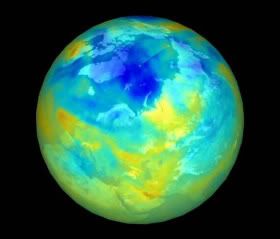Polar stratospheric clouds (shown) have formed over large areas of the Arctic, which could signal coming losses of protective ozone, new research suggests.
Credit: Ross J. Salawitch/University of Maryland
 Trioxygen, more commonly known as Ozone (O3), is a polar molecule consisting of three oxygen atoms. It is a pale blue gas found throughout the atmosphere, and depending on its location, it can be noxious or beneficial.
Trioxygen, more commonly known as Ozone (O3), is a polar molecule consisting of three oxygen atoms. It is a pale blue gas found throughout the atmosphere, and depending on its location, it can be noxious or beneficial.
In the troposphere (the lowest portion of the Earth’s atmosphere) it is considered a pollutant, and is formed by the reactions of volatile organic compounds (VOCs) and nitrogen oxide gases (NOx) in the presence of sunlight. These compounds and gases are produced by numerous sources, from human-made causes such as industrial emissions and gasoline fumes, to natural phenomenon such as the emission of compounds like isoprene or pinene by different types of trees. Ground-level ozone is harmful to breathe, damaging to crops, and is a primary ingredient of what we call smog.
Beneficial ozone is produced naturally in the stratosphere, particularly the “bottom” portion, commonly called the ozone layer. It serves as a sort of “barrier,” absorbing over 97% of the ultraviolet light emanating from the sun which can be damaging to life on Earth. Ozone depletion (resulting in the formation of ozone “holes”) has a plethora of negative effects on humans, other animals, and vegetation.
Ozone hole around South Pole in 2003. View of the South Pole from NASA’s TOMS (Total Ozone Mapping Spectrometer) satellite. Blue and green indicate relatively large amounts of ozone. Red and yellow mark the “ozone hole”, an area of decreased ozone. (Credit: NASA)

